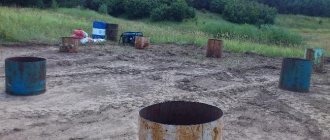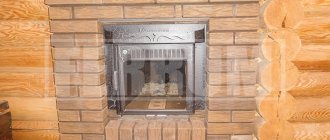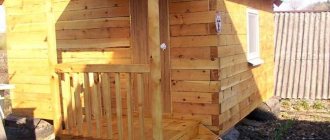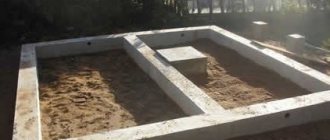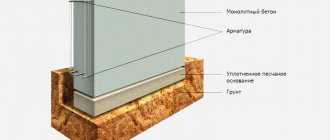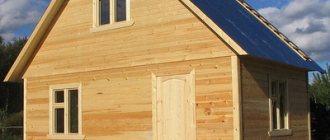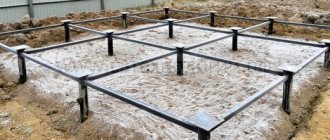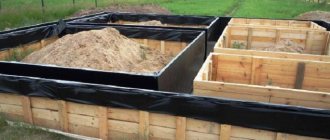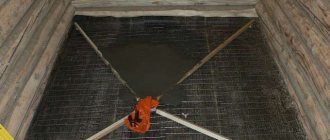The choice of foundation for a new bathhouse depends on the soil that lies on the building site. Before starting construction, it is important to determine what type of soil predominates in the area chosen for the bathhouse. The presence of underground sources and the maximum groundwater level should be studied - the use of a certain type of foundation support used for a bathhouse depends on these indicators. The depth of soil freezing in winter has a significant influence on the choice of foundation.
Soil research
Using a hand-held probe, you need to drill several wells in the construction area and take rock samples. It is best to do this in the spring, when the soil is most saturated with moisture. Since it is almost impossible to independently assess the condition of the soil, contact an engineering company for accurate readings.
Attention! Be sure to take into account the freezing depth! The foundation, located at a shallow depth, where the soil freezes, begins to collapse very quickly. This is due to the fact that water expands when it freezes, breaking the structure of the soil and foundation material.
For a small log building, the depth of the wells should be more than five meters, and for heavy structures, brick or stone, at least eight meters.
Based on the information obtained as a result of research, you can determine which type of foundation is best for you.
The foundation is the most expensive and labor-intensive part of the building, and if you decide to build a foundation that will be located in a swamp with your own hands, you should not skimp on materials and the services of professional geologists.
Return to content
What kind of foundation to build on loam
Loamy soil is a mixture of clay and sand in which clay predominates.
The percentage of components can be different, hence the different properties of loam. For example, the more sand there is, the greater the porosity coefficient and the lower the calculated soil resistance. When dry, loams are usually crumbly - this property is provided by the sand filler. But when wet they become viscous - thanks to the clay. Due to the presence of a significant part of the latter, moistened loams freeze at subzero temperatures, increasing in volume. Therefore, special requirements are imposed on foundations on heaving soils (clay, sandy loam, loam). Based on specific construction conditions, individual developers rely on the following types of foundations:
- reinforced slab. In this case, we are talking, as a rule, about a floating foundation laid above the HGT;
- piles. Recessed below the GPG, they provide good stability of the building, but their use must be justified by operational and economic factors;
- strip foundation. On heaving soils, a rigid reinforced tape is erected either above the GPG (for light buildings and subject to drainage and insulation of the foundation), or below - you get a house with a basement
Pile type foundation
The pile type of foundation is designed specifically for construction in “problem” areas.
This type of structure has a number of advantages over others.
1. Pile foundation is the least expensive.
2. This structure allows for significant site unevenness and uneven soil. The use of piles of different sizes makes it possible to smooth out strong slopes.
3. Special processing of piles in production makes them resistant to corrosion, which is extremely necessary when building a foundation in a swamp with your own hands, since they will be used in a rather aggressive environment.
4. Speed of construction. You will not have to make allowances for weather conditions, and the construction of a pile foundation itself will not take much time, since you do not have to wait for the concrete solution to dry and harden.
5. Strength and durability. Thanks to the peculiarities of its design, it will serve you for a very long time without strong shrinkage, even with such capricious and unstable soil.
To work in wetlands, piles of at least twenty-five meters in length are used. There are two ways to immerse them in the soil: by pressing and also by vibration immersion. For the first case, driven piles are used, and for the second, screw piles are used. The most important thing is that the base of the pile enters a stable area of soil, bypassing groundwater and sand. The lining of such a foundation is made with reinforced concrete supports.
Return to content
Pile foundation for a bathhouse
Visually, this type of foundation for a bathhouse resembles a columnar foundation. The only exception is that to create a durable structure, metal piles are used, which are placed in the ground at a distance of 3 to 20 m.
After the piles are installed in strategically important places (ceilings, wall structures, building corners and high-pressure zones), they are fastened together with a grillage. This element helps to create a perfectly flat structure on which the base of the bathhouse will subsequently be laid.
Among all the variations of bases, this option is one of the most expensive, and at the same time reliable and durable. Structures of this type can withstand large buildings with a large mass, any type of soil and other adverse influences.
The most popular variations of pile foundations are screw and bored foundations.
Screw foundation for a bathhouse
The metal pipe is equipped with a special blade, which is responsible for uniformly screwing the mechanism into the ground. In addition, the blade becomes an element of additional fixation after the pile is completely immersed in the soil.
Only metal products that have high protection against corrosion can be used as piles. In addition, it is recommended to cover them with an additional layer of paint with a high level of adhesion. It will create additional anti-corrosion protection and prevent rust.
The only difficulty when installing a foundation of this type will be that in order to immerse it in the soil, it is necessary to adhere to a special technique that will control the depth and level of verticality of immersion.
Important! Under no circumstances should low quality metal be used as piles. Otherwise, it may bend at the stage of screwing in the pile, which will negatively affect the operational parameters of the entire structure.
Bored foundation for a bathhouse
To equip the base for a bathhouse of this format, you must perform the following steps:
- Wells are drilled in the ground, the depth of which will correspond to the necessary parameters for driving the pile.
- A metal frame made of reinforcement is installed in the wells, the purpose of which is to fix the hole and prevent it from being subsequently covered with earth.
- Concrete is poured over the reinforcement frame, which, when hardened, forms a solid foundation for the construction of the building.
This option has several disadvantages. One of them is the high cost of the project. In the case of building a bathhouse, laying a bored base will significantly increase the cost of work and materials. In addition, it is extremely difficult to carry out all the actions on your own; you will have to hire professional builders and special equipment.
Slab foundation
A slab foundation is indispensable if you decide to build a solid house made of stone, as it can withstand heavy loads and sudden temperature changes. It is, of course, much more expensive than all other structures, but its design is such that the uniform distribution of the mass of the entire building on the surface will not allow the structure to sag under the influence of various weather conditions (soil freezing), and the sand and gravel cushion located at its base will easily allow groundwater to pass through, below the structure itself, without harming it. Such monoliths are also called drift foundations. Before you start building such a foundation in a swamp with your own hands, you need to carefully prepare the place.
1. Clear the construction site of all kinds of vegetation, such as trees, shrubs, and windbreaks, if any.
2. Dig a pit for the future foundation. On marshy soils, it is not necessary to remove a large layer of soil. The construction of a basement is excluded.
3. Carry out work to drain the pit. If there is not too much water, you can use a drainage system, but if there is an abundance of moisture, sometimes it is necessary to use pumps.
4. Place a layer of sand at the bottom of the drained pit and compact it well. The sand is covered with a layer of gravel on top. This way, you will build a sand cushion that will prevent groundwater from eroding the foundation of your house.
5. Cover sand and gravel with two to three layers of waterproofing material, such as roofing felt.
6. Make formwork for pouring the concrete mixture. The size of the monolith should be commensurate with the perimeter of the future structure. To correctly calculate the thickness of such a foundation, contact a specialist. You should not act relying only on your own strength and knowledge.
7. Build a reinforcing frame from metal rods at least twelve millimeters thick.
8. Prepare the required volume of concrete solution and pour it into the formwork. Make sure that the concrete is poured evenly and avoid the formation of voids.
9. The resulting slab should harden well and dry for several days, under favorable weather conditions. After the slab has dried, dismantle the used formwork.
Return to content
Sandy foundation for a bathhouse in wheeled barrels
Water practically does not linger in sand, which makes it an ideal material for foundations. However, it is worth pointing out some features of this material. Wet sand can compact its structure, which can cause soil displacement.
Therefore, it is recommended to use a sand cushion before laying the foundation. It can be wheels and barrels filled with crushed stone, gravel or the same sand. The sand layer will allow you to quickly get rid of excess water, which is especially important for areas where groundwater is close to the surface.
Strip foundation type
It is also called shallow. If you decide to build a foundation of this type in a swamp with your own hands, you need to know that in comparison with the above structures, this is the most inexpensive foundation, but it is only suitable for light wooden buildings. Its effectiveness is due to its excellent drainage system and removal of excess moisture.
Having previously cleared the site for construction, we begin to lay the foundation.
1. In order to lay this type of foundation, proceed according to a scheme similar to that used to build a monolithic one, only instead of a foundation pit, you will have to dig a trench of the desired shape along the perimeter of the future building.
2. Just as in the previous case, a sand cushion is poured.
3. Formwork and reinforcing frame are constructed according to the shape of the trench.
4. Take care of effective water outflow and build drainage.
5. Pour the concrete solution and wait for it to dry.
6. After drying and dismantling the formwork, carry out the necessary waterproofing. The foundation in the swamp, made with your own hands, is ready, you can start building walls.
If you did everything correctly, observing all the necessary measures, then the saying: “my home is my castle” will come true for you. Good luck with your construction.
Return to content
Do-it-yourself foundation installation: choosing the type of work
If you don’t know which foundation is best to install in swampy areas with your own hands, then give preference to a slab
If you don’t know which foundation is best to install in swampy areas with your own hands, then give preference to a slab. This type of base, even with large volumes of work, can be completely done with your own hands. As special equipment you will only have to rent an excavator to prepare the pit and a construction mixer with ready-made mortar. Otherwise, you can do everything yourself
If you prefer a pile foundation, then you should know that it is better to entrust the work to professionals. Since only craftsmen can clearly control the evenness of the well under the pile, its depth and the uniformity of filling the column with mortar. In addition, only a competent operator can work with drilling rigs.
Video
We bring to your attention a video about the features of the foundation of a house on marshy soil, what problems you will encounter and how to solve them.
Swampy soils are subject to seasonal fluctuations to a greater extent than other soils. They are oversaturated with fine particles and therefore often form floaters. In winter they freeze and swell, in spring they are washed away when groundwater rises. Laying a foundation in a swamp with your own hands is a difficult task, but quite solvable. The main thing is to study the soil and choose the right type of support and its depth.
Preliminary work
Soil research
It is imperative to establish the composition of the soil and its changes at different horizons, as well as determine the occurrence of water carriers and evaluate the terrain. You can conduct the research yourself, but it is better to involve specialists in this. To analyze the soil content, you will have to drill several wells at different points, or dig pits.
Drainage of the site
If the soil is not very swampy, it is enough to drain the area to avoid flooding of the future structure.
In some cases, the thickness of the peat layer is small and can simply be removed. Then the foundation is established on stable rock, which is located below. Its form is adopted taking into account other technological or financial considerations.
In other cases, you will have to choose from two options:
- pile foundation;
- monolithic slab.
The project is finally approved taking into account the design of the building and the total pressure on the foundation.
How to build a foundation in a swamp
Construction of a foundation in a swamp
A pile foundation allows you to go through unstable layers and rest on reliable soil that can support heavy loads.
Pile foundation in a swamp
Typically, several types of piles are used for construction:
- Screw metal. Not very durable, since iron will quickly oxidize in an acidic environment;
- Hammers. Their installation is expensive and requires the use of construction equipment, but access to the site can be difficult;
- Bored. Installed on pre-drained soils. Creating a foundation using such piles involves a large amount of work and is also expensive.
Whatever type of supports you choose, a grillage is finally built on top of them. For wetlands, it is made in the form of a reinforced concrete floor.
A monolithic slab foundation is a universal tool for constructing the support of a house in swampy areas. It is expensive, but quite reliable. The base turns out to be floating, and the large area of the sole distributes loads well from all sides. This allows you to avoid deformations of the building and its individual elements.
How to make a slab foundation
Monolithic foundation
Step #1. Before pouring the slab, you need to prepare the soil underneath it. The top layer is removed by about a meter and a cushion of gravel, stones and sand is poured. Sometimes it is partially replaced with construction waste. Everything is thoroughly wetted and compacted. This sand and gravel backfill allows groundwater to move under the sole without being delayed, and to swell less in winter.
Step #2. A thin layer of cement mixture is spread over the pillow as a substrate. It should smooth the surface of the crushed stone. It will dry out within 48 hours and then the insulation can be installed. Typically, 10 cm thick foam or polystyrene foam boards are used for this.
Step #3. Several rows of rolled waterproofing material, such as roofing felt, are laid on top. It will not allow soil moisture to be absorbed through capillaries into the concrete base. It is even better to use polymer diffusion membranes. They not only protect concrete from water from below, but also, due to their vapor-permeable properties, remove moisture from it.
Step #4. The formwork is being installed. The removable fence is assembled from boards fastened with nails, but you can use permanent sheets of foam plastic, which will also serve as insulation.
Step #5. Reinforcement for a foundation in a swamp should be chosen with increased strength, with a rod diameter of 12–16 mm. A two-level mesh is formed with a cell size of 15x15 cm. Dressings are made with steel wire.
Step #6. Concrete is poured at one time so that no seams are formed inside, weakening the structure. The solidified mass is treated with a deep vibrator to remove air from it. Finally, the surface is leveled with a vibrating screed. The slab will dry and gain strength for at least a month. To ensure that the process proceeds evenly, the area is covered with PVC film and wetted from time to time. The readiness of the foundation can be determined using the same polyethylene: when condensation stops settling on it, the process is complete.
Step #7. The formed slab must be protected from moisture on the top and sides with coating waterproofing. It will protect the concrete from freezing and mechanical damage.
With a small budget, it is very difficult to build a foundation in a swampy area. Even on light and dry soils, pouring supports takes from 1/5 to 1/3 of the total cost of the house. Therefore, you need to decide on the type of foundation and building materials even before purchasing a plot of land, and for this you need to have complete information about it.
Is your home built on marshy soils? Tell us about its construction and the quality of the constructed foundation by leaving a comment on the article.
Video
We recommend watching a video about the construction of a monolithic foundation on a peat site.
Never drying out swampy soil with moisture-loving vegetation that can be systematically moistened is not the most favorable place to build a house frame. The close location of groundwater creates seasonal fluctuations in soil, especially during spring warming. Modern construction technologies can solve the problem of how to organize a foundation in a swamp so that it can withstand the load of a house.
Foundation in a swamp - which one is better? Construction on wetlands
If your site, which you plan to use to build your house, has swampy soil, you should not be upset. Modern technologies easily make it possible to lay a foundation even in difficult conditions. The main rule in this case will be the correct choice of the type of base. You cannot make a mistake, because the service life of not only the foundation itself, but also the entire building, will depend on this.
What is swampy soil?
Before you begin building a DIY foundation in a swamp, you should become familiar with this type of soil. It is a heterogeneous multilayer structure, which provides for the presence of:
The swamp is always oversaturated with moisture and has large quantities of fine-grained particles. They resist compression quite weakly. The soil is unstable, so determining the maximum load is quite difficult.
Swampy soil is one of the most difficult for construction. Before determining the foundation depth, type of foundation and area of the structure, it is necessary to study the geological situation.
Features of construction in wetlands: geological studies
If you decide to lay the foundation for a house in a swamp, then at the first stage you must carry out geological research. They are necessary to determine soil parameters. It will be necessary to find out what the volume of soil water is, to what level freezing occurs, the type of soil, as well as the surface proximity of groundwater.
To sample soil, you must use a hand probe. Wells are drilled on the site, which are located in the corners of the future foundation. It is better to carry out research in winter, when the soil is most saturated with moisture. Soil sampling allows you to obtain the following information:
- thickness of layers;
- physical properties of the soil;
- depth of formations;
- soil changes in recent years.
For a wooden house, 5-meter wells are drilled, while if you are planning to build a stone or brick house, then the depth of the well must be increased to 10 m.
Before starting construction on a wetland, the depth of soil freezing should be determined. If the foundation is laid at insufficient depth, this may subsequently cause its destruction. As a result of geotechnical research, you will receive information that will allow you to determine the type of soil.
Which foundation is better to choose?
The most labor-intensive and expensive process in building a house is the foundation work. The cost of these manipulations will be 1/3 of the total cost estimate for the construction of the building. After a few years, any foundation in a swamp begins to collapse, but only if it does not reach the depth of seasonal freezing.
On the south side, the base begins to bulge if the work was carried out incorrectly. In order for the structure to last as long as possible, it is necessary to make a drainage system. It will remove excess moisture from the area. On swampy soils, three types of foundation are used, one of them is pile.
This design is the most suitable because it has the following advantages:
- relatively low cost;
- the ability to carry out construction in any terrain;
- increased durability;
- high stability and strength;
- excellent corrosion resistance.
Screw piles for the foundation can be installed in any weather. Construction time is very short. You can complete the foundation installation in 2 days. If you use supports of different heights, you can smooth out surface unevenness.
The main part of the foundation is a pile, which can be installed vertically or with a slight slope into the ground. The supports are connected using a grillage, which is a cushion in a reinforcement frame.
Screw piles for foundations are one of the types of supports used in swampy areas. These products are protected from corrosion by zinc coating or mastic. Screwing is carried out using a special lever. Piles can be reinforced concrete; they are driven with a hand pile driver. An alternative solution is complex combined piles that are placed in a casing pipe. They are removed after the supports are installed and the site is concreted.
Construction of a foundation based on bored piles
The foundation in a swamp may consist of bored piles. It is built using one of several technologies, including:
- with waterproofing;
- with permanent formwork;
- with removable formwork.
Covers are installed in the drilled holes, which are welded from polyethylene film. The walls are lined with roofing felt, and concrete is poured inside. When creating a pile, you can use removable formwork made of metal or plastic. 2 hours after pouring, the strength of the concrete will be sufficient to preserve the structure. The formwork is pulled out after the mortar has hardened.
Such supports have one drawback, which is that they are not protected from moisture. But the impact of the frozen layer can be neutralized by creating a sand cushion.
A foundation on drilled piles in a swamp can be created using the third method, when the formwork is not removed. In this case, it will perform the function of waterproofing. The technology involves the use of pipes made of the following materials:
- special cardboard;
- asbestos cement;
- metal
This method allows you to protect the piles by eliminating height differences and creating a layer of sand between the supports and the walls of the well. Before installing the structure, water from the well is pumped out by a pump. The lower part of the pipe, which acts as formwork, is filled with waterproofing concrete to a height of one meter.
Such a foundation in a swamp requires increasing the strength of the support. For this, frames made of metal 1.2 cm rods are used. You can also use triangular designs.
Should I choose a slab foundation?
One of the most expensive, but reliable is a slab foundation. It can withstand heavy loads and sudden temperature changes. The weight of the building will be evenly distributed over the entire area of the structure, which will eliminate the possibility of subsidence. Under the slab there is a sand and gravel cushion that allows groundwater to pass through, preventing damage to the foundation.
Carrying out construction on a wetland. Slab foundation - is it suitable?
If the area has marshy soil, then you can build a slab foundation. At the first stage, a shallow pit is dug, and then it is drained using pumps or drainage. Layers of sand and gravel are laid at the bottom, which are well compacted and covered with several layers of roofing felt.
To pour concrete, formwork is installed, and a reinforcing frame is constructed from 1.2 cm rods. The prepared area is filled with solution and then left to dry for several days. After this, the formwork can be dismantled.
Such a foundation in a swamp is poured in one go; a strip foundation can be installed on top. It is done on your own, is durable, and when it shrinks, it protects the walls from the formation of cracks. This technology is relevant for those who want to have a basement in their home.
An alternative option is a shallow strip foundation
A strip foundation in a swamp is one of the cheapest, but is only relevant for buildings made of a metal frame or wooden beams. Such a foundation requires a good drainage system, since the structure is laid above the freezing point of the soil. The tape must be monolithic, this ensures the ability to resist soil heaving.
The structure will rise and fall evenly along with the soil. The tape will require a sand cushion, as well as thermal insulation of the base. Such a foundation in a swamp can be poured independently, following the technology. The work is not too difficult.
Construction of a strip foundation
If you decide to build a strip foundation, then first you need to dig a trench of the desired shape. A sand cushion is placed on the bottom, and then a reinforcement frame is installed.
If water appears at the bottom, then you should get rid of it by constructing drainage. Next, the formwork is installed and the mixture is poured, which should be left until it hardens. When everything is dry, the surface is covered with waterproofing.
Finally
Peat bogs and marshy areas are some of the most difficult soils to build on. Wetland soils are oversaturated with moisture and are prone to the formation of unstable quicksand. In winter, such soil is subject to frost heaving, and in spring – erosion. The solid layer lies at a considerable depth, which excludes the possibility of using some types of foundation.
For wetlands, it is best to use floating foundations, also called monolithic slabs. The structure will be solid, thanks to this there will be no partial shift of the house, and distortions and destruction of the walls will be excluded.
Soil analysis
What does swampy land represent? This is an area with a porous structure, which is 90% water. The remaining percentage is formed by chaotically located particles of minerals - peat, sand, clay. The unsystematic order of occurrence of rocks does not allow calculating the load on the soil. Soil studies on the site will help identify the following characteristics of the area:
- type of soil mass;
- groundwater volume;
- freezing depth;
- distance of the aquifer from the surface.
The data obtained make it possible to determine the physical properties of the layers, their thickness and depth, and to characterize changes in the soil over the past few years. Based on geological expertise, you can choose which foundation to build in marshy areas.
Features of constructing a foundation for a bathhouse on clay soils
Digging a trench on clay soil
The foundation for a bathhouse on soils containing clay can withstand heavy loads only if the groundwater lies at a significant depth from the surface.
If the clay soil is constantly wet, it is better not to waste time and effort on calculating different options for strip supports, but to immediately stop at using piles. Despite the high cost, a pile foundation will pay for itself in a few years, but the bathhouse is guaranteed to have a stable foundation.
In clayey soils, it is most important to install underlying layers of sand and crushed stone. A cushion made of inert materials can prevent the occurrence of deformations.
How to explore the soil yourself?
It is not advisable for summer residents to delve into the details of geodetic surveys. Private developers need to take a number of simple measures:
- selection of earthen material from four wells. The drilling depth is 5 m for wooden structures, 8 m for large stone buildings. It is better to probe the surface in the spring, when it contains the maximum amount of moisture.
- Mechanical analysis is carried out by taking a small piece of earth. It rolls out in your hands and bends into a ring. A disintegrated element indicates sandstone, an unstable element indicates loam, a dense element indicates clay;
- inspection of vegetation. On excessively moist marshy soils, wild rosemary, blueberries, sedge, cloudberries, horsetail and other crops are present.
Research and determination of soil type include determining changes in groundwater level.
Why does base deformation occur and how to avoid it
Despite the fact that clay is the most difficult type of soil for construction, we will help you figure it out.
Building a foundation on clay is not an easy task, you will be able to understand all the nuances after reading this article.
Surely, even without expert advice, you understand perfectly well that the likelihood of breaking, swelling and subsidence of the main structure are the main problems when building a foundation on clay. This can happen due to insufficient foundation depth, or if too much pressure is applied to the foundation.
If you want to avoid such problems, then you should choose the right type of foundation for the future structure. The blocks can be folded back immediately, because you will need to mount a reinforcing frame, which will act as a connecting element. In addition, it is better to make the bottom of the base wider than the top. If there are concerns about the pressure of freezing soil, then coat the foundation with machine oil or use PVC film.
Pile frame
A base designed for wetlands. Supporting elements are piles that are driven into the soil. A pile foundation in a swamp allows you to solve the problem of heaving, instability of the top layer of the earth, and allows you to smooth out the unevenness and slope of the territory. Advantages of the structure:
- low-cost, non-labor-intensive process (in 2 days you can build a supporting structure);
- mounting the frame reduces the amount of earthwork: garbage removal, digging a pit, concreting;
- the ability to choose building materials for piles: wood, steel, reinforced concrete;
- increased strength, long service life.
It is rational to use a pile foundation in swampy, unstable terrain with a high groundwater level. There are several limitations to consider when choosing a support structure:
- weak bearing capacity in horizontally moving soil;
- additional financial costs for the arrangement of the basement (filling voids).
The average depth of a well pit is 10-15 m. To mount a pile frame at a high groundwater level, use pillars at least 25 m long. The piles must be driven in until they fit tightly to the ground.
Selection of foundation structure
If you do not expect to share money with geological exploration specialists, then you will have to analyze the soil yourself. To do this, at the proposed construction site it is necessary to dig several pits (holes) to a depth below the GPG (approximately 30 cm). The meaning of the latter can be approximately determined from the figure from this article.
Instead of pits, it is convenient to drill wells, for which you can use a regular garden drill. Already at the drilling (digging) stage, the nature of the soil, the uniformity of its occurrence, and changes in its composition with increasing depth are assessed. It is likely that there will be a layer of clay below the loam, and the foundation will have to be built on clay.
It is worth noting that such exploration work is recommended to be carried out in the spring, when the groundwater level is closest to the surface. Groundwater can cause unnecessary trouble when laying a foundation, and the choice of the optimal type of foundation for a house depends on it. Already at the stage of geological exploration it will be clear whether they are below the GGT (ideal case) or above (you will have to resort to additional work, which will be discussed below).
You can independently determine the composition of the soil using a simple garden drill by making a well 1.5-2 m deep in the proposed construction site. Based on the data obtained, experts are considering the following options for foundation construction:
- A strip shallow foundation is suitable when the top layer of earth (30 cm) is composed of fertile soil, a mixture of clay, sand, peat and groundwater occurs at a depth of more than 2 m;
- The strip base is also preferable in the case of inclusion of rocks, the presence of dense layers of coarse sand;
- A columnar or pile foundation is installed on clayey and weak soils with a freezing depth of more than 0.7 m, as well as when building on slopes;
- A slab base is the optimal solution for heaving and bulk soils, wetlands, since it may not be buried at all, regardless of the freezing mark of the ground.
Advice! It is preferable to order soil testing on a site from a specialized organization - in this case you will receive the most accurate information.
In any case, it is better to entrust the calculation of the foundation structure to specialists, since in addition to the type of soil, it is necessary to take into account the depth of freezing of the ground, the number of storeys of the building, the material of the walls, roofs, snow and other loads.
The structure consists of reinforced strips of reinforced concrete located under load-bearing walls. The shallow-type base is economical, as it requires significantly less material consumption and labor costs due to its relatively low height. It is calculated using the formula: H=0.5*K, where K is the depth of soil freezing. Accordingly, this value during construction, for example, in the Yekaterinburg region on fine sandy soils will be 0.5 * 1.91 = 0.955 meters.
Shallow strip foundations have a relatively low load-bearing capacity, therefore they are used in the construction of low-rise buildings from fairly light materials. On this type of foundation, a 3x4 meter bathhouse with the following wall structures can be erected:
- Log house;
- Lightweight brickwork;
- Frame-panel construction;
- Log house made of timber;
- Masonry made of cellular concrete - gas silicate, foam concrete blocks.
Advice! When constructing log houses and a bathhouse with an attic, the width of the foundation should be slightly increased - this will increase the load-bearing capacity of the structure and reduce the depth of freezing of the ground under the building.
The principle of constructing a shallow shallow foundation:
- Markings on the ground - for a 3x4 m bathhouse these are the walls around the perimeter;
- Digging trenches with a calculated depth of plus 0.2 m and a width of 0.4 m;
- Installation of a carefully compacted sand cushion of 0.2 m, which must be moistened abundantly to prevent shrinkage;
Advice! The density of the bedding is checked as follows: the sole of the shoe should not be imprinted if you step on a layer of sand.
- Construction of formwork from boards with waterproofing of walls and bottom with polyethylene;
- Laying and bundling of frame reinforcement;
- Pouring concrete solution.
The structure is a system of supports located in increments of maximum 2 m under the load-bearing walls of the bathhouse, at the points of their connection:
- Drilling wells to a depth of ground freezing plus 0.3-0.5 m;
- Installation of compacted sand cushion;
- Pouring a layer of concrete - it will serve as the base of the pile;
- Installation in the well until the solution has completely hardened, of an asbestos-cement pipe with a diameter of about 100 mm with 3 reinforcement bars placed inside;
- Filling the surrounding voids with soil, while simultaneously leveling the shape strictly vertically;
- Pouring concrete solution;
- Installing a sheet steel cap at the top of the pile.
A foundation of this type can serve as a reliable base for the construction of a permanent bathhouse made of bricks or blocks. In this case, a reinforced concrete grillage will be required, which will slightly increase the cost of construction, but the total material consumption when constructing a pile foundation is significantly lower than when constructing a full-fledged strip structure. When constructing a frame bathhouse, a wooden base is mounted on piles, on which the walls and floor are built.
Attention! A separate foundation is laid for the furnace.
This type of foundation is rarely used in the construction of baths due to its high cost, and for the construction of 3x4 m it is justified only in the case of the construction of a second floor. The structure is essentially a monolithic reinforced concrete or wooden slab. This type of base can be recessed (0.5-0.7 m) or not recessed, and may or may not have stiffeners.
The principle of constructing a slab foundation:
- Construction of a pit;
- Laying geotextiles;
- Backfilling and compacting a sand cushion of 0.2-0.3 m;
- Installation of sewerage and water supply;
- Installation of a 0.2 m concrete screed using gravel as a filler;
- Waterproofing the foundation with polymer or roll materials;
- Construction of a slab of timber laid in 2-3 rows in a transverse direction relative to each other, or laying mesh of reinforcement and pouring concrete 0.2-0.3 m thick.
This type of foundation is the most common in private construction, due to its versatility for erecting walls from any materials, ease of construction, lack of need for specialized equipment and cost-effectiveness.
Step-by-step work on the construction of a strip foundation:
- Site preparation, including clearing it of debris, uprooting stumps, and leveling.
- Marking the axes of the building on the ground is done using pegs about 0.7 m long, installed at the corners of a 3x4 m rectangle (with a tolerance of 0.1 m on each side) and connected with a rope.
- Geometry check: angles must be 90°, permissible deviation in diagonal dimensions is 20 mm.
- Digging a trench, the depth of which is determined by calculation for a given climatic zone, and the width is 0.25 (foundation dimensions) 0.15 m (reserve for formwork construction).
- Leveling the bottom of the trench and backfilling with 0.1 m fine gravel and 0.1 m sand, watering and thoroughly compacting each layer.
- From 20-30 mm boards, formwork is made 150 mm higher than the design top of the structure.
- Brick bricks are freely poured onto the bottom of the trench - this measure is intended to penetrate concrete from all sides of the reinforcement frame and protect its metal from corrosion.
- Reinforcement with a diameter of 16 m is laid in the longitudinal direction and tied with wire.
Attention! The use of welding to fix the frame rods to each other is undesirable, since the connection will corrode in the concrete solution and will then lead to deformation of the entire foundation.
- Placing 80 mm ceramic pipes in the transverse direction at intervals of 3 m - they will create natural ventilation of the structure.
- Pouring concrete mortar in uniform layers of 0.2 m with periodic compaction.
- Installation of vertical reinforcement pins into the poured base.
- Tapping with a wooden hammer to remove air from the concrete mass.
Advice! Self-production of concrete mortar: minimum grade M250 cement, fine-grained sand, fine crushed stone and water in a ratio of 1: 3: 3.5: 0.5.
- The formwork is dismantled after 2 weeks.
- After the concrete has completely hardened, the duration of which depends on weather conditions (approximately 14 days), you can begin building the walls.
The correct choice of the type of foundation, its proper calculation and adherence to technology during installation ensures the durability of the entire construction of the bathhouse. To determine the volume of consumables, you can use ready-made reference tables.
You have already determined the type of soil on your site, found out the depth of groundwater and the depth of soil freezing. Now it's time to choose a base. There are two possible options in this case: a strip foundation on clay or a pile foundation. If the soil is more or less homogeneous, then a strip foundation is installed, while a pile foundation is used if there are stones in the soil.
Your future structure will also influence the choice of foundation type, for example, if your house is built from foam block or brick, then a strip foundation is the best option. This choice is due to the serious load that will be placed on the base.
Work algorithm for constructing a foundation on piles
Construction work is permissible at any time of the year.
- We treat the tongues with an antiseptic to prevent the development of corrosion.
- We plunge the piles into the ground: we screw in the driven ones, and for the screw ones we use a special lever.
- Cut off the excess protruding part.
- We fill hollow pipes with cement.
- Using an electric welding machine, we mount the support platforms on the cut parts of the piles.
- We treat the surface with a waterproofing solution.
- We connect the structure along the heads with a horizontal grillage.
High speed of construction and resistance to soil vibrations make it possible to increase the service life of the structure.
Pile foundation
Pile foundations are erected in cases where soil with better compression resistance characteristics than loam is found at shallow depths. It is relevant to lay such supports for small houses, log houses, frame buildings, bathhouses, etc., when the load of the future structure makes it possible to economically justify the use of piles. This refers to the required quantity. In this regard, we recommend that you familiarize yourself with the information presented in this article.
Slab foundation
The structure is widely used for the construction of a monolithic stone building. Concrete slabs are resistant to temperature changes and loads. The problem of high groundwater levels is solved with the help of a sand and gravel cushion located at the base of a monolithic slab, buried to the level of soil freezing. Rocks allow spring flows below their location, which prevents deformation. The sequence of technological steps will allow you to create a solid slab foundation in the swamp.
- We prepare the wetland, clear it of vegetation and debris.
- We drill holes in the corners of the future structure.
- We drain the trench. For groundwater levels up to 2 meters from the surface, use pumps; from 2 meters and below, limit yourself to the drainage system.
- We will strengthen the bottom of the pit with an embankment of sand and gravel. This will protect the foundation from the effects of groundwater. We form roofing felt flooring on top.
- We make formwork from lumber.
- We install reinforcement made of metal rods along the entire perimeter of the form-building structure.
- We fill the trenches with concrete mixture in several approaches. The thickness of each layer should not exceed 0.2 m.
- Dismantle the concrete form after the solution has dried (it will take several days).
- We treat the vertical and horizontal surfaces of the frame with waterproofing mastic.
A foundation in a swamp made of monolithic slabs is an expensive type of construction. Changes in soil heaving will not affect the reliability and strength of the frame. Therefore, slab foundations are mainly used for marshy areas.
How to make a foundation for a bathhouse in a damp place?
It happens that a purchased or allocated plot for the construction of a dacha and the entire dacha economy is not particularly suitable for capital construction. It is very difficult to build a foundation for any building, for example a house or a bathhouse, for very simple reasons. The site may have a high groundwater level and no rainwater drainage from the site. It may be located on a peat bog or swamp, which may periodically flood and which is constantly damp.
Choosing a foundation on screw piles
To build a bathhouse in such places, this issue must be solved comprehensively and at the lowest cost, so that drainage and drainage of the site does not turn out to be very expensive. And the first thing you need to do is choose a suitable foundation.
In order for the foundation to stand for a long time even in a damp place, it can be made not of concrete, but of a screw. For this, screw piles are used, which are screwed to a depth below the freezing depth and will cost much less than draining the site and building a strip foundation. To do this, you may need to remove all the soil from under the bathhouse. Next, pour a cushion of sand, and then place a monolithic strip foundation on top of it.
Screw piles for a bathhouse are installed at corners, at intersections with internal walls, every 1.5-2 meters and under a heavy brick stove with a pipe. In total, a 6x6 bathhouse requires about 16 screw piles, which are installed manually during the day. The upper level of the piles is set at 0.5 meters from the ground. The outer surface of the piles is galvanized and is not afraid of contact with water and aggressive media. For greater reliability, if constructively possible, reinforcement is inserted inside the pipe and concrete is poured.
To close the base, you can monolith screw piles into a suspended strip foundation, which will not rest on the ground, or cover it with sheets of fiberglass board. All wood - timber, boards that go to the lower crowns and will be directly exposed to dampness - are treated several times with an antiseptic or treated in a mixture with bitumen mastic so that the wood is saturated.
We make the correct drainage on the site
Second, and no less important than the adequate choice of foundation type, is the work of constructing drainage. It is necessary to lower the groundwater level throughout the entire area or locally around the bathhouse. To do this, ditches are dug towards the slope or around the site so that water accumulates in them. All soil is transported to the site, which increases its level.
All drainage can be taken to one place and a small pond can be dug, from which water can be periodically discharged with a hose. Instead of a reservoir, you can dig two concrete rings into the ground in the lowest place on the site, connect drainage ditches to a drainage well and periodically discharge water from it.
Depending on the installation conditions and soil, you can choose one of the two available types of drainage.
The problem of high groundwater levels and swampy areas can only be solved with the help of drainage
Drainage in the form of pipes is installed immediately during construction, or when problems with groundwater arise in the presence of existing buildings. The components of the system are drainage pipes. For their production, plastic or, less commonly, ceramics are used. The drains are connected in series by pipes that are discharged into a sump, in the absence of the possibility of natural drainage.
When installing pipes, geotextiles and crushed stone are used, which act as filtering agents and prevent the drainage system from clogging. Servicing such a system does not take much time and is not difficult. This includes cleaning the sump well at least once a year and pressure flushing the pipes every three to four years.
Drainage pipes laid in accordance with design requirements, as a rule, run along the walls and, in addition, in large spaces they are laid in parallel or in a herringbone pattern.
Surface drainage is used when it is not possible to construct internal, buried drainage and the groundwater level is very high. This type of drainage is best done at the stage of foundation construction. However, there is also the option to do it later.
In any situation, if the issue of building a bathhouse in a damp, wetland area arises, you cannot avoid the two indicated ways to solve it. Since a screw foundation and a drainage system in conjunction represent the most effective, reliable and inexpensive way to carry out independent construction.
Tape base
A shallow foundation for a house is suitable for the construction of small frame structures made of wood. The peculiarity of the type of supporting structure is that the depth of the masonry is higher than the freezing level of the soil. When arranging the feed, you need to take into account a number of nuances:
- The role of the drainage system is performed by a cushion of sand and gravel.
- When the soil heaves, the reinforced frame rises slightly, but the use of monolithic technology allows it to maintain its shape and prevent the appearance of cracks.
- At the design stage, soil characteristics should be determined. This will allow you to calculate the effect of loads on the future construction and determine the safety margin.
- The sequence and technique of performing the work of arranging a foundation, which is located in a swampy area and is relevant in case of high groundwater loss, is identical to laying a deep-depth tape - digging a pit, forming a cushion, constructing formwork, reinforcement and layer-by-layer pouring of cement mortar.
- It is advisable to install a channel for water drainage along the entire perimeter of the foundation at a distance of 1.5 - 3.00 m.
Ease of installation and low cost make the tape popular as a foundation on marshy soil. Dampness and moisture have a destructive effect on the frame. It is difficult to predict how soil density will change over time. To avoid the effects of swelling of the ground, use waterproofing systems. When choosing the type of foundation that will be located in soft, swampy terrain, focus on the climatic conditions of the area, the type of structure and the budget.
Today we will conduct an experiment - build a foundation for a bathhouse as budget as possible, that is, try to meet the minimum amount. You don't need the smallest one, it must have a steam room, a shower veranda and a shed behind for firewood. We decided to do six by six. The base will be square. Not very high, about two meters. Construction is being carried out on marshy soil, so there are features that will be taken into account.
The video continues. So watch the channel. At the end of the publication, the second part is about building the frame. The bathhouse will be divided into two parts. The building will be divided exactly in the middle. At the back there is simply a canopy, an open space in which firewood and some materials and agricultural implements can be located. And on the other side there will be a bathhouse itself with a veranda.
This part will be the veranda, the division. Accordingly, a steam room, a washing room and a locker room. We'll put the stove here.
Veranda with windows for relaxation. A door and a room with a tiny window. Pipe with smoke. The part above the veranda is made of yellow transparent polycarbonate, so that the veranda is bright and nice.
Let's install a dense roof with andulin or tiles. Let's look at the money. It will be insulated over the steam room. It will not be transparent above the sink.
It was decided to make the foundation from tires because the area is very swampy. A larger support area is needed and this helps these supports slide. They are not so squeezed, they walk less under the structure.
This house was built 10 years ago and its foundation was made of tires. Having marked the perimeter of the bathhouse, we begin to prepare a place for supports. We dig a hole on the bayonet of a shovel, put 2 buckets of sand inside and put a tire. Then we pour the concrete. You will need water, sand, cement and stones. Despite all the handicrafts of this method, it works great. After everything is poured, a strong support is obtained.
How to make a bath frame
Electrical safety is needed in any bathhouse, and especially in a swampy area.
Columnar foundation for a bathhouse
This type of foundation is most often found in regions where there are certain climatic difficulties. If the soil freezes strongly in winter, or in spring and autumn there is abundant water in the area where the bathhouse is located, a columnar foundation will be the ideal solution.
A columnar foundation made of concrete blocks differs from others in that its main load falls on the pillars dug in at key points. Most often these are corners of the building, places of increased load and areas of intersection of wall ceilings.
The pillars must be spaced evenly so that the load is distributed between them in the same volume. To further reduce pressure, the posts should have an extension at the bottom.
Important! Experts recommend adhering to the standard rule: the distance between adjacent pillars should be a maximum of 3 m.
The top of the pillars remains on the surface. They are fastened together using a grillage, which will perform a function related to the formation of structural stability. Walls made of block material will subsequently rest on this element.
In fact, the pillars are the main fastening, so they must be as strong and reliable as possible. Brick, asbestos-cement pipes, concrete and natural stone are used as materials for pillars. There is no point in installing wooden structures, since they have a limited service life.
Depending on the depth of the pillars, the foundation is of two types:
- Shallow. The level of immersion of the pillars into the ground is small, 40-50 cm.
- With full depth. The most durable type of base. The pillars are located in the ground below the freezing level by 15-20 cm. This ensures the strength of the fastenings and the stability of the structure.
In the case of building a bathhouse, it is recommended to install a columnar foundation only in situations where the structure is erected from lightweight materials and does not have significant dimensions and weight. It should be borne in mind that before starting construction it is better to order a geological analysis of the site. This will help avoid many unexpected situations.
Or maybe it’s still tape?
Often houses on loam are built on a strip foundation. You can build a shallow strip foundation (obvious savings), or a structure buried below the GPG. The last option is most often chosen when building a house with a basement. It is the most material-intensive and therefore not the cheapest. In general, it is advisable to build reinforced concrete strips in situations where geological exploration revealed that the soil layers lie evenly throughout the construction site. In such situations, you can count on the absence of serious uneven deformations during heaving.
Preparatory stage
At the first stage of construction, a full soil study is carried out. For this, a hand-held probe can be used to take soil samples. This method is used in the construction of light wooden buildings and structures.
The probe is lowered into a well 5 m deep. During the capital construction of stone or brick houses, serious geological exploration is required. In this case, the depth of measurements is 8-10 m. Wells for measurements are located in the corners of the future structure. There must be at least four such measurements (wells). Determine indicators of soil composition and depth of its layers; level, quantity and composition of groundwater. One more indicator is needed - this is the freezing point of the soil.
The upper layers of marshy soil are mainly peat. Clay and sandstone may follow. Peat is a porous, completely loose material with low compression resistance and increased instability. If the layer thickness is small, the peat is removed and the foundation is placed on the lower hard rocks.
A shallow foundation is arranged so that it can rise and fall slightly during heaving processes occurring in the soil. Thanks to this, it does not crack and retains its shape. This base is not used for brick and stone houses. If the peat layer on the construction site is deep enough (more than 5 meters), it is necessary to strengthen the foundation with piles.
Not only the peat layer is a problem when building a foundation on swampy soil. The second problem is the nearby groundwater. There are two ways to combat this problem:
- lower the water level;
- raise the area.
The installation of a drainage system helps to significantly reduce the groundwater level. To drain water from the construction site, trenches are dug to a depth of about two meters, and the entire drainage system is led to drainage wells. A layer of crushed stone is poured into the trench and drainage pipes are laid on it. Drained water from wells is pumped out using submersible pumps.
To raise the site, you need to make an embankment of stone and sand. To do this, remove the top, weak layer of soil and fill the area with a layer of stone and sand. Such an embankment is carefully compacted and compacted with rollers.
We invite you to familiarize yourself with Calculation of the foundation of a chimney
Types of foundations and their pros and cons
Swampy soil is a difficult base for a foundation. In this case, two types of foundations can be used: pile and slab. A pile foundation is reinforced with metal or concrete piles; a slab foundation is made in the form of a monolithic reinforced concrete slab, which is poured onto a sand-granite bed.
Slab
A slab foundation is designed to ensure that the load of the building is uniform across the entire base of the slab. Such a base can withstand increased loads and is used not only in individual, but also in industrial construction.
Slab technology is applicable on heavily swampy soils, unevenly compressed soils, and with a high groundwater supply. However, the disadvantage of such a foundation is that it is inappropriate to install it on slopes. If there is even a slight slope, the slab can “slide”. The special advantages of a slab foundation include its high load-bearing capacity. The only drawback here is the increased consumption of materials, which is a very painful fact for individual construction.
To pour such a foundation, you will need many times more reinforcement and concrete than when installing a foundation on solid soils, which, naturally, will entail an increase in the entire final cost of the building.
Pile
Installing a pile foundation in swampy areas is more reasonable and has its advantage in the direction of uneven terrain. Piles can be placed in any hard-to-reach place, on slopes, on any technically difficult soil. Among the advantages of a foundation on piles is not only its installation in hard-to-reach areas with complex terrain and unstable soil, but the advantage is the speed of installation of piles and an affordable price.
The opinion that a pile foundation is more suitable for small, lightweight structures is incorrect. By increasing the number of supports, the highest possible bearing capacity of the foundation is achieved, which is in no way inferior to the parameters of the slab base. However, at the same time, the costs of such a foundation will increase and its cost will be equal to that of a slab foundation.
Laying a foundation on clay
Scheme of installing a columnar foundation on clay soils using TISE technology.
Clay soils (with a clay content of about 10-30%) are very plastic, subject to erosion, do not hold their shape and can shift. The stability of houses on them depends on the correct laying of the foundation.
Ways to strengthen the soil:
- mechanical compaction using technical equipment (skating rink);
- electroosmosis. Rod terminals under voltage of up to 5 A/m2 are inserted into the soil ball. After exposure to current, the desired area becomes denser and drier, which minimizes heaving;
- electrochemical influence. In addition to current, special mixtures are added to the soil (for example, calcium chloride);
- partial replacement of soil. The top layer of soil is removed to a depth of 1 m and a more durable layer is filled in, which is compacted layer by layer.
If there are slopes, they are reinforced with concrete stops or panels, at a slope of 50-60 relative to the slope.
Conclusion
Building a supporting structure for a wooden house on clay is not such a difficult process if you approach it wisely and carefully. However, we should not forget about the specificity of this type of soil. You need to skillfully take advantage of the advantages of such soil and avoid its disadvantages.
How to restore strength to an older man. Sokolov: Restored potency at 60 years old!
Write the recipe: add 3 drops to... Read more on Dmitry Sokolov’s blog. How to restore potency! Guys! Potency returned at 60 years old! For pennies I regained my iron POTENTITY! Write down the recipe: take one...
